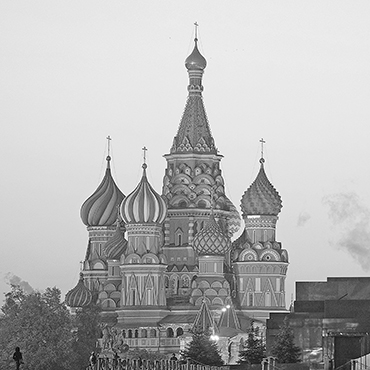HOW RUSSIAN AUTHORITIES ARE TRACKING ACTIVISTS
In recent years, Russia's security services have dramatically expanded their electronic surveillance of the nation's citizenry and adopted sophisticated technologies that have facilitated large-scale roundups of protesters and opposition figures. Those are the findings of a new report from the investigative NGO OVD-Info. According to the study, entitled "How Authorities Use Cameras And Facial Recognition Against Protesters," the mass detention of participants at last year's pro-Navalny protests in Moscow was made possible by an extensive web of cameras that Russian authorities claim is "one of the largest in the world." These technologies – including more than 3,500 cameras connected to a Unified Data Storage and Processing Center – are part of the Kremlin's "Safe City" program, and include capabilities like facial recognition and "urban video surveillance."
This system has proven extremely effective in identifying activists, who are subject to "post-factum" apprehension and prosecution. Nor has the pandemic – with its ubiquitous mask wearing – substantially diminished the effectiveness of the program. In at least one case, the OVD report notes, "a person was detained on the basis of a photo and video, although in both images he was wearing a medical mask." And increasingly, the program has begun to proliferate to other Russian urban centers. "Although [it] was most often reported by residents of Moscow, this practice is not limited to the capital: similar evidence was received from at least 17 other cities" from across the length and breadth of the Russian Federation, the study notes. (OVD, January 2022)
RUSSIA'S NEW "CROWD CONTROL" ROBOT
In their efforts to control public gatherings and social protests, Russian authorities now have a new tool, writes Paul Goble in his Window on Eurasia blog. The Kabardino-Balkar Scientific Center of the Russian Academy of Sciences in Nalchik, he notes, has developed the Cherepakha (Turtle), a self-propelled crowd control robot designed to disperse and detain protestors. The Cherepakha consists of a radio-controlled mobile unit directed by radio signals, and, when operated in a group, can "use electro shocks to disable people." The robots will be equipped with shields, quick hardening foam, nets, and stun guns in order to corral demonstrators with little risk to law enforcement personnel. While still in the prototype phase, many are already hailing the Cherepakha as a tool for the country's police and military to deal with large protests more safely and efficiently. (Window on Eurasia, January 15, 2022)
THE KREMLIN VERSUS CRYPTOCURRENCY
Russia's central bank is urging a ban on cryptocurrency in the country. In a new report, the institution has made the case that cryptocurrencies constitute a "significant threat to the well-being of Russian citizens" and to the stability of Russia's financial system. The report also cited the threats associated with the use of cryptocurrency as a method of payment for illegal activities. As the annual volume of Russia's cryptocurrency transactions nears 350 billion rubles ($5 billion), the head of the Central Bank, Elvira Nabiullina, expressed concern that "undesirable organizations" and "foreign agents" could tap into the rapidly growing market. The proposed ban, Bank officials make clear, won't make it illegal for Russians to own cryptocurrency. Instead, it would prohibit the use of Russian infrastructure for buying and selling digital money. (Meduza, January 20, 2022)
FEARS OF A KREMLIN COUP PLOT FOR KYIV
As tensions continue to deepen over Ukraine, Western nations are accusing the Kremlin of planning a series of subversions on the territory of the former Soviet republic. The British government, for instance, recently charged that Moscow is plotting to install a figure friendly to Russia to lead Ukraine's government - even identifying Yevhen Murayev, a former Ukrainian MP, as the likely candidate. Murayev lost his seat in parliament in the 2019 elections after his party failed to secure enough votes in the Ukrainian Rada. The British Foreign Office also named several other Ukrainian politicians who it said maintained links with the Russian intelligence services, including Mykola Azarov, Volodymyr Sivkovych, Serhiy Arbuzov, and Andriy Kluyev. Several of these political figures worked under Ukraine's pro-Russian President Viktor Yanukovych prior to his ouster in 2014. (BBC, January 23, 2022)
THE GROWING RISK OF A LIMITED WAR
If Russia does move militarily against Ukraine, what form is the conflict most likely to take? That's the question the Center for Defense Strategies, a Ukrainian national security and defense think tank, tackled in a recent analysis. The Center's conclusion is that, while "[a] full-scale invasion capturing most or all of Ukraine in the near future seems unlikely," there nonetheless "are other threatening scenarios that may materialize."
"At the moment, there are not enough Russian troops on Ukraine's borders and no fully formed military groups needed to conduct a strategic offensive against Ukraine," the report's authors write. "According to our estimates... a large-scale general military operation can't take place for at least the next two or three weeks. At the same time, Russia could add more troops near Ukraine's borders by: 1) assembling new formations and units in the Southern and Western military districts of Russia; 2) transferring troops to Belarus for exercises; 3) deploying land forces, the Navy and the airborne forces to military training grounds near the border of Ukraine and in occupied Crimea; [and] 4) increasing the number of Russian troops 150-300 kilometers away from the state border of Ukraine," they note.
But the risks of a more limited conflict are very real. "[A]ccording to available information, Russia's National Guard units conducted a series of combat training in Belarus and occupied Crimea throughout 2021," the authors conclude. "This may indicate Russia's preparation for actions in the occupied territories, especially in eastern Ukraine. Similarly, active measures are being taken to accumulate stocks of food, fuels and lubricants, and other material resources for the Russian army." (Kyiv Independent, January 24, 2022)
Want these sent to your inbox?
Subscribe

